fuel consumption CITROEN C4 SPACETOURER 2022 Owners Manual
[x] Cancel search | Manufacturer: CITROEN, Model Year: 2022, Model line: C4 SPACETOURER, Model: CITROEN C4 SPACETOURER 2022Pages: 316, PDF Size: 10.36 MB
Page 8 of 316

6
Eco- driving
Eco-driving is a range of everyday practices
t hat allow the motorist to optimise their fuel
consumption and CO
2 emissions.
Optimise the use of your
gearbox
With a manual gearbox, move off gently
a nd change up without waiting. When
accelerating, change up early.
With an automatic gearbox, give preference
to automatic mode and avoid pressing the
accelerator pedal heavily or suddenly.
The gear efficiency indicator invites you to
engage the most suitable gear: as soon as the
indication is displayed in the instrument panel,
follow it straight away.
For vehicles fitted with an automatic gearbox,
this indicator appears only in manual mode.
Drive smoothly
Maintain a safe distance between vehicles,
u se engine braking rather than the
brake pedal, and press the accelerator
progressively. These practices contribute
towards a
reduction in fuel consumption and
CO
2 emissions and also help reduce the
b
ackground traffic noise.
Control the use of your electrical
equipment
Before moving off, if the passenger
compartment is too warm, ventilate it by
opening the windows and air vents before
using the air conditioning.
Above 31
mph (50 km/h), close the windows
and leave the air vents open.
Consider using equipment that can help
keep the temperature in the passenger
compartment down (sunroof blind and window
blinds, etc.).
Switch off the air conditioning, unless it has
automatic regulation, as soon as the desired
temperature is attained. Switch off the headlamps and front foglamps
when the ambient light level does not require
their use.
Avoid running the engine before moving off,
particularly in winter; your vehicle will warm up
much faster while driving.
As a
passenger, if you avoid connecting your
multimedia devices (film, music, video game
etc.), you will contribute towards limiting the
consumption of electrical energy, and so of
fuel.
Disconnect your portable devices before
leaving the vehicle.
Limit the causes of excess
consumption
Spread loads throughout the vehicle; place
the heaviest items in the bottom of the boot,
as close as possible to the rear seats.
If your vehicle has cruise control, make use of
the system at speeds above 25
mph (40
km/h)
when the traffic is flowing well. Switch off the demisting and defrosting
controls when not required, if they are not
automatically controlled.
Switch off the heated seat as soon as
possible.
Eco-driving
Page 9 of 316
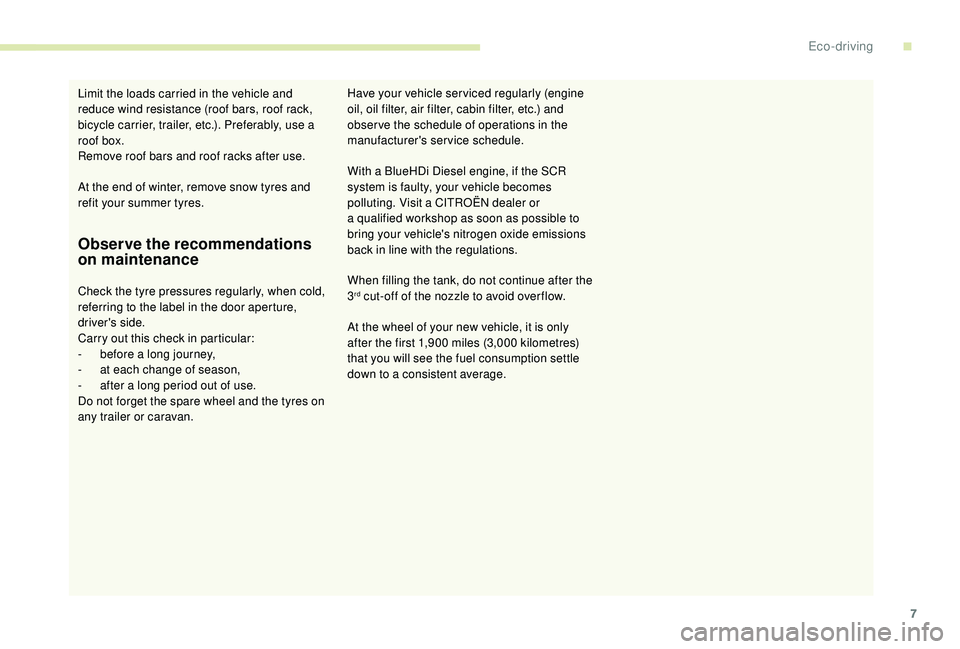
7
Observe the recommendations
on maintenance
Check the tyre pressures regularly, when cold,
referring to the label in the door aperture,
driver's side.
Carry out this check in particular:
-
b
efore a long journey,
-
a
t each change of season,
-
a
fter a long period out of use.
Do not forget the spare wheel and the tyres on
any trailer or caravan. Have your vehicle ser viced regularly (engine
oil, oil filter, air filter, cabin filter, etc.) and
obser ve the schedule of operations in the
manufacturer's service schedule.
With a
BlueHDi Diesel engine, if the SCR
system is faulty, your vehicle becomes
polluting. Visit a CITROËN dealer or
a qualified workshop as soon as possible to
bring your vehicle's nitrogen oxide emissions
back in line with the regulations.
When filling the tank, do not continue after the
3rd cut-off of the nozzle to avoid over flow.
At the wheel of your new vehicle, it is only
after the first 1,900
miles (3,000 kilometres)
that you will see the fuel consumption settle
down to a
consistent average.
At the end of winter, remove snow tyres and
refit your summer tyres. Limit the loads carried in the vehicle and
reduce wind resistance (roof bars, roof rack,
bicycle carrier, trailer, etc.). Preferably, use a
roof box.
Remove roof bars and roof racks after use.
.
Eco-driving
Page 38 of 316
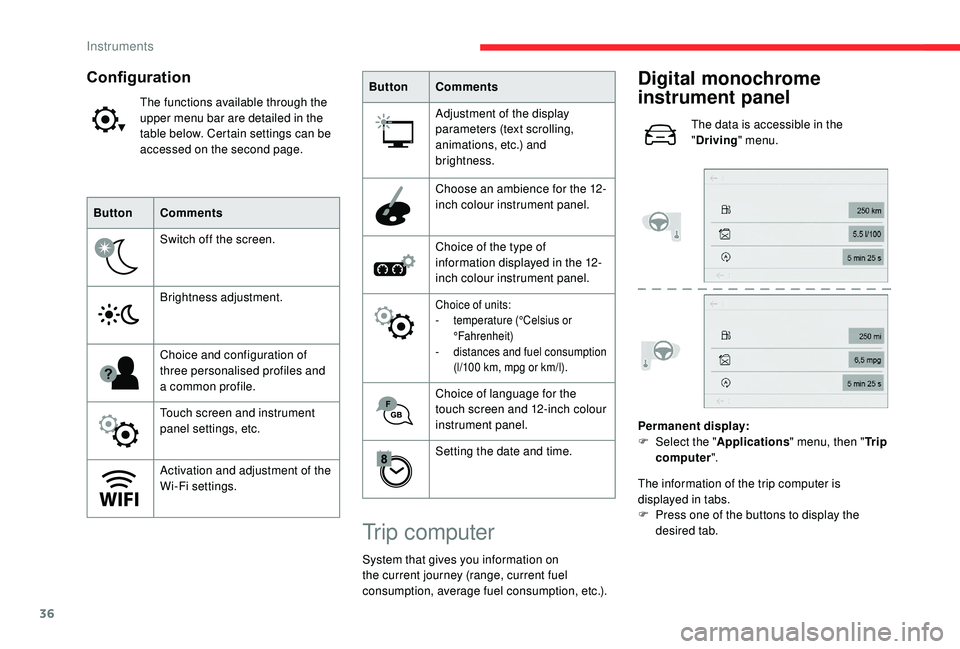
36
The functions available through the
upper menu bar are detailed in the
table below. Certain settings can be
accessed on the second page.
Configuration
ButtonComments
Switch off the screen.
Brightness adjustment.
Choice and configuration of
three personalised profiles and
a
common profile.
Touch screen and instrument
panel settings, etc.
Activation and adjustment of the
Wi-Fi settings. Button
Comments
Adjustment of the display
parameters (text scrolling,
animations, etc.) and
brightness.
Choose an ambience for the 12-
inch colour instrument panel.
Choice of the type of
information displayed in the 12-
inch colour instrument panel.
Choice of units:
- t
emperature (°Celsius or
°Fahrenheit)
-
d
istances and fuel consumption
(l/100
km, mpg or km/l).
Choice of language for the
touch screen and 12-inch colour
instrument panel.
Setting the date and time.
Trip computer
System that gives you information on
the current journey (range, current fuel
consumption, average fuel consumption, etc.).
Digital monochrome
instrument panel
The data is accessible in the
"Driving " menu.
Permanent display:
F
Sel
ect the " Applications " menu, then " Tr i p
computer ".
The information of the trip computer is
displayed in tabs.
F
P
ress one of the buttons to display the
desired tab.
Instruments
Page 39 of 316
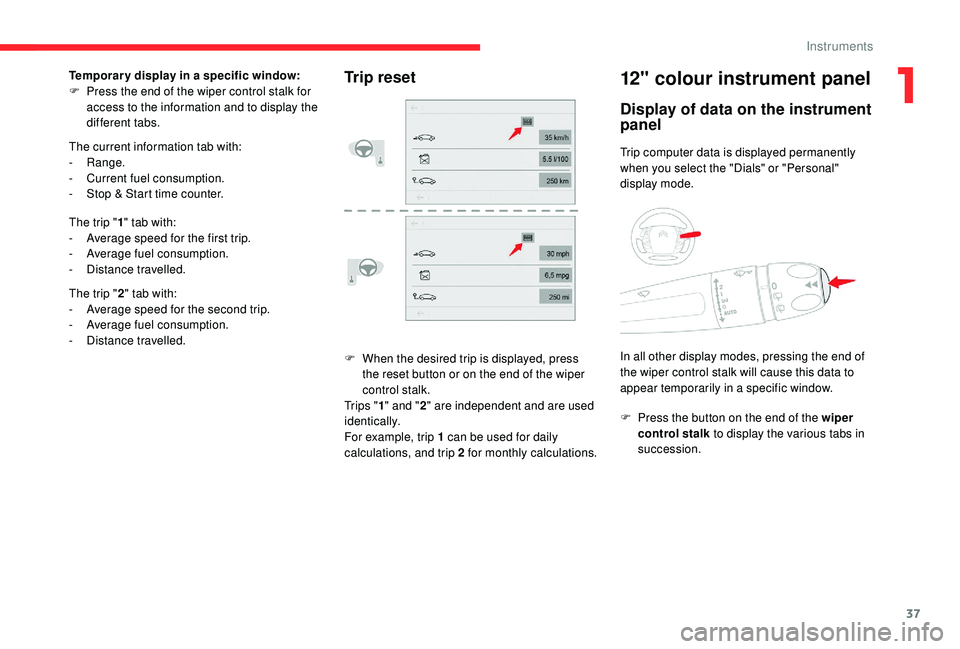
37
F When the desired trip is displayed, press the reset button or on the end of the wiper
control stalk.
Tr i p s " 1" and " 2" are independent and are used
identically.
For example, trip 1 can be used for daily
calculations, and trip 2 for monthly calculations.
12" colour instrument panel
Display of data on the instrument
panel
Trip computer data is displayed permanently
when you select the "Dials" or "Personal"
display mode.
F
P
ress the button on the end of the wiper
control stalk to display the various tabs in
succession.
The current information tab with:
-
Range.
-
C
urrent fuel consumption.
-
S
top & Start time counter.
The trip " 1" tab with:
-
A
verage speed for the first trip.
-
A
verage fuel consumption.
-
D
istance travelled.
The trip " 2" tab with:
-
A
verage speed for the second trip.
-
A
verage fuel consumption.
-
D
istance travelled.
Trip resetTemporar y display in a specific window:
F P ress the end of the wiper control stalk for
access to the information and to display the
different tabs.
In all other display modes, pressing the end of
the wiper control stalk will cause this data to
appear temporarily in a specific window.
1
Instruments
Page 40 of 316
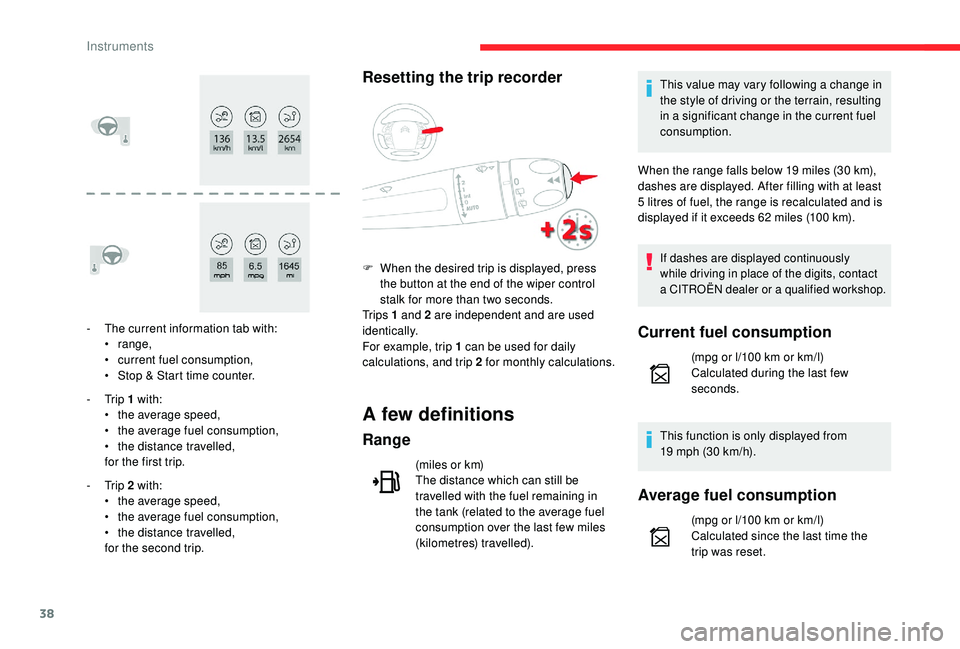
38
- The current information tab with:• range,
•
c
urrent fuel consumption,
•
S
top & Start time counter.
-
Trip 1
with:
•
t
he average speed,
•
t
he average fuel consumption,
•
t
he distance travelled,
for the first trip.
-
Trip 2
with:
•
t
he average speed,
•
t
he average fuel consumption,
•
t
he distance travelled,
for the second trip.
Resetting the trip recorder
F When the desired trip is displayed, press the button at the end of the wiper control
stalk for more than two seconds.
Tr i p s 1
and 2 are independent and are used
identically.
For example, trip 1
can be used for daily
calculations, and trip 2
for monthly calculations.
A few definitions
Range
(miles or km)
The distance which can still be
travelled with the fuel remaining in
the tank (related to the average fuel
consumption over the last few miles
(kilometres) travelled). This value may vary following a
change in
the style of driving or the terrain, resulting
in a significant change in the current fuel
consumption.
When the range falls below 19 miles (30 km),
dashes are displayed. After filling with at least
5 litres of fuel, the range is recalculated and is
displayed if it exceeds 62 miles (100 km).
If dashes are displayed continuously
while driving in place of the digits, contact
a
CITROËN dealer or a qualified workshop.
Current fuel consumption
(mpg or l/100 km or km/l)
C alculated during the last few
seconds.
This function is only displayed from
19 mph (30 km/h).
Average fuel consumption
(mpg or l/100 km or km/l)
C alculated since the last time the
trip was reset.
Instruments
Page 63 of 316
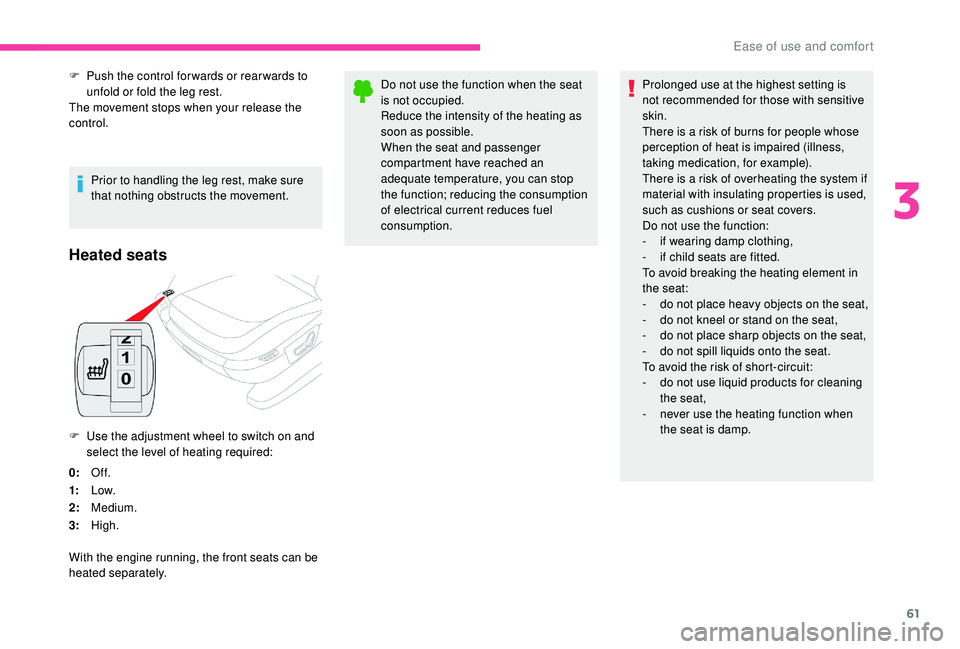
61
Heated seats
F Use the adjustment wheel to switch on and select the level of heating required:
0: Of f.
1: Low.
2: Medium.
3: High.
With the engine running, the front seats can be
heated separately. Do not use the function when the seat
is not occupied.
Reduce the intensity of the heating as
soon as possible.
When the seat and passenger
compartment have reached an
adequate temperature, you can stop
the function; reducing the consumption
of electrical current reduces fuel
consumption.
Prolonged use at the highest setting is
not recommended for those with sensitive
skin.
There is a risk of burns for people whose
perception of heat is impaired (illness,
taking medication, for example).
There is a risk of overheating the system if
material with insulating properties is used,
such as cushions or seat covers.
Do not use the function:
-
i
f wearing damp clothing,
-
i
f child seats are fitted.
To avoid breaking the heating element in
the seat:
-
d
o not place heavy objects on the seat,
-
d
o not kneel or stand on the seat,
-
d
o not place sharp objects on the seat,
-
d
o not spill liquids onto the seat.
To avoid the risk of short-circuit:
-
d
o not use liquid products for cleaning
the seat,
-
n
ever use the heating function when
the seat is damp.
F
P
ush the control for wards or rear wards to
unfold or fold the leg rest.
The movement stops when your release the
control.
Prior to handling the leg rest, make sure
that nothing obstructs the movement.
3
Ease of use and comfort
Page 79 of 316
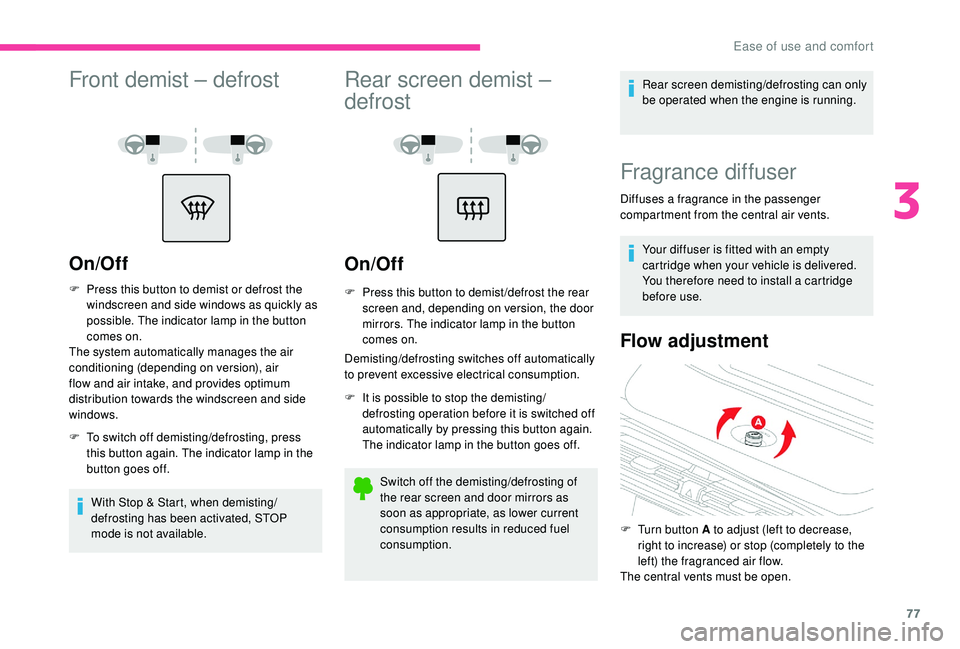
77
Front demist – defrost
On/Off
F Press this button to demist or defrost the windscreen and side windows as quickly as
possible. The indicator lamp in the button
comes on.
The system automatically manages the air
conditioning (depending on version), air
flow and air intake, and provides optimum
distribution towards the windscreen and side
windows.
F
T
o switch off demisting/defrosting, press
this button again. The indicator lamp in the
button goes off.
With Stop & Start, when demisting/
defrosting has been activated, STOP
mode is not available.
Rear screen demist –
defrost
On/Off
F Press this button to demist /defrost the rear screen and, depending on version, the door
mirrors. The indicator lamp in the button
comes on.
Demisting/defrosting switches off automatically
to prevent excessive electrical consumption.
F
I
t is possible to stop the demisting/
defrosting operation before it is switched off
automatically by pressing this button again.
The indicator lamp in the button goes off.
Switch off the demisting/defrosting of
the rear screen and door mirrors as
soon as appropriate, as lower current
consumption results in reduced fuel
consumption. Rear screen demisting/defrosting can only
be operated when the engine is running.
Fragrance diffuser
Diffuses a fragrance in the passenger
c ompartment from the central air vents.
Your diffuser is fitted with an empty
cartridge when your vehicle is delivered.
You therefore need to install a
cartridge
before use.
Flow adjustment
F Turn button A to adjust (left to decrease, right to increase) or stop (completely to the
left) the fragranced air flow.
The central vents must be open.
3
Ease of use and comfort
Page 140 of 316
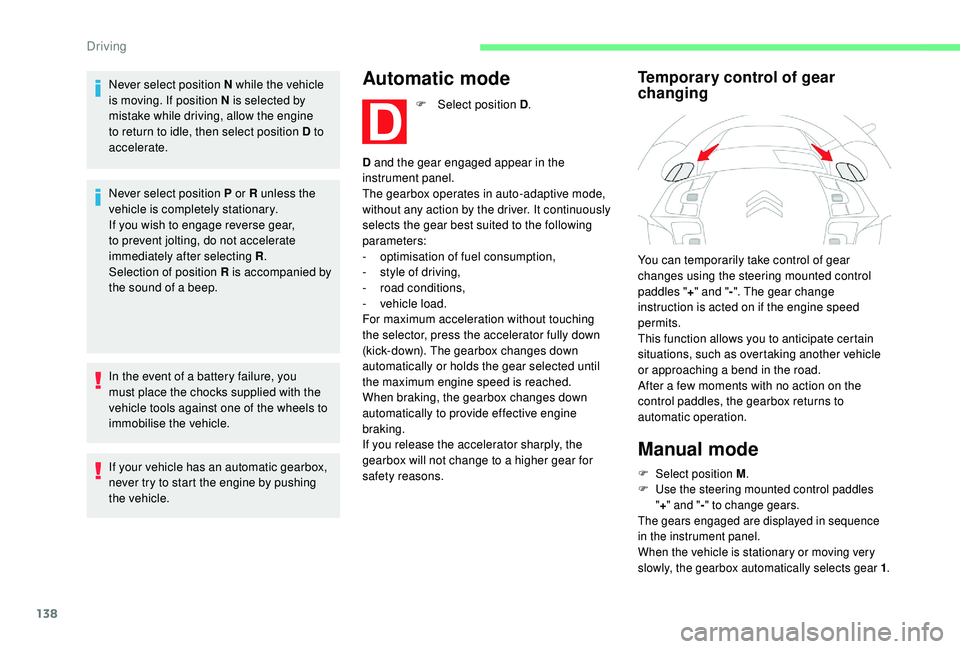
138
Never select position N while the vehicle
is moving. If position N is selected by
mistake while driving, allow the engine
to return to idle, then select position D to
accelerate.
Never select position P or R unless the
vehicle is completely stationary.
If you wish to engage reverse gear,
to prevent jolting, do not accelerate
immediately after selecting R.
Selection of position R is accompanied by
the sound of a
beep.
In the event of a
battery failure, you
must place the chocks supplied with the
vehicle tools against one of the wheels to
immobilise the vehicle.
If your vehicle has an automatic gearbox,
never try to start the engine by pushing
the vehicle.Automatic mode
F Select position D .
D and the gear engaged appear in the
instrument panel.
The gearbox operates in auto-adaptive mode,
without any action by the driver. It continuously
selects the gear best suited to the following
parameters:
-
o
ptimisation of fuel consumption,
-
s
tyle of driving,
-
r
oad conditions,
-
v
ehicle load.
For maximum acceleration without touching
the selector, press the accelerator fully down
(kick-down). The gearbox changes down
automatically or holds the gear selected until
the maximum engine speed is reached.
When braking, the gearbox changes down
automatically to provide effective engine
braking.
If you release the accelerator sharply, the
gearbox will not change to a
higher gear for
safety reasons.
Temporary control of gear
changing
You can temporarily take control of gear
changes using the steering mounted control
paddles " +" and " -". The gear change
instruction is acted on if the engine speed
permits.
This function allows you to anticipate certain
situations, such as overtaking another vehicle
or approaching a
bend in the road.
After a
few moments with no action on the
control paddles, the gearbox returns to
automatic operation.
Manual mode
F Select position M .
F U se the steering mounted control paddles
" + " and " -" to change gears.
The gears engaged are displayed in sequence
in the instrument panel.
When the vehicle is stationary or moving very
slowly, the gearbox automatically selects gear 1 .
Driving
Page 141 of 316
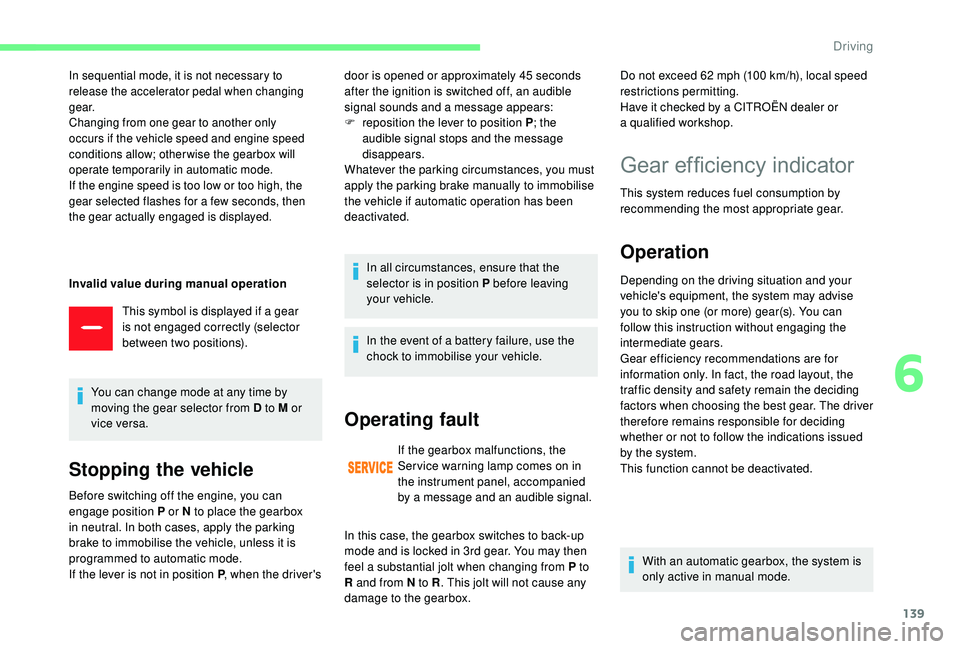
139
In sequential mode, it is not necessary to
release the accelerator pedal when changing
g e a r.
Changing from one gear to another only
occurs if the vehicle speed and engine speed
conditions allow; other wise the gearbox will
operate temporarily in automatic mode.
If the engine speed is too low or too high, the
gear selected flashes for a few seconds, then
the gear actually engaged is displayed.
Invalid value during manual operation
This symbol is displayed if a gear
is not engaged correctly (selector
between two positions).
You can change mode at any time by
moving the gear selector from D to M or
vice versa.
Stopping the vehicle
door is opened or approximately 45 seconds
a fter the ignition is switched off, an audible
signal sounds and a
message appears:
F
r
eposition the lever to position P ; the
audible signal stops and the message
disappears.
Whatever the parking circumstances, you must
apply the parking brake manually to immobilise
the vehicle if automatic operation has been
deactivated.
In all circumstances, ensure that the
selector is in position P before leaving
your vehicle.
Before switching off the engine, you can
engage position P or N to place the gearbox
in neutral. In both cases, apply the parking
brake to immobilise the vehicle, unless it is
programmed to automatic mode.
If the lever is not in position P , when the driver's In the event of a
battery failure, use the
chock to immobilise your vehicle.
Operating fault
If the gearbox malfunctions, the
Ser vice warning lamp comes on in
the instrument panel, accompanied
by a
message and an audible signal. Do not exceed 62
mph (100 km/h), local speed
restrictions permitting.
Have it checked by a CITROËN dealer or
a
qualified workshop.
In this case, the gearbox switches to back-up
mode and is locked in 3rd gear. You may then
feel a
substantial jolt when changing from P to
R and from N to R . This jolt will not cause any
damage to the gearbox.
Gear efficiency indicator
This system reduces fuel consumption by
recommending the most appropriate gear.
Operation
Depending on the driving situation and your
vehicle's equipment, the system may advise
you to skip one (or more) gear(s). You can
follow this instruction without engaging the
intermediate gears.
Gear efficiency recommendations are for
information only. In fact, the road layout, the
traffic density and safety remain the deciding
factors when choosing the best gear. The driver
therefore remains responsible for deciding
whether or not to follow the indications issued
by the system.
This function cannot be deactivated.
With an automatic gearbox, the system is
only active in manual mode.
6
Driving
Page 142 of 316
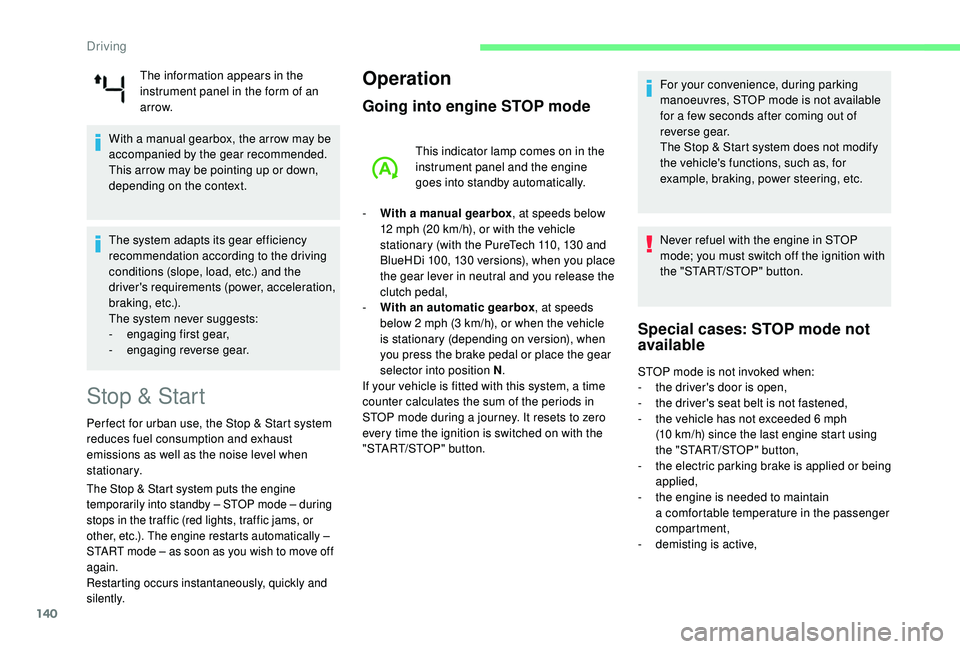
140
The information appears in the
instrument panel in the form of an
ar row.
With a
manual gearbox, the arrow may be
accompanied by the gear recommended.
This arrow may be pointing up or down,
depending on the context.
The system adapts its gear efficiency
recommendation according to the driving
conditions (slope, load, etc.) and the
driver's requirements (power, acceleration,
b r a k i n g , e t c .) .
The system never suggests:
-
e
ngaging first gear,
-
enga
ging reverse gear.
Stop & Start
Per fect for urban use, the Stop & Start system
reduces fuel consumption and exhaust
emissions as well as the noise level when
stationary.
The Stop & Start system puts the engine
temporarily into standby – STOP mode – during
stops in the traffic (red lights, traffic jams, or
other, etc.). The engine restarts automatically –
START mode – as soon as you wish to move off
again.
Restarting occurs instantaneously, quickly and
silently.
Operation
Going into engine STOP mode
This indicator lamp comes on in the
instrument panel and the engine
goes into standby automatically.
-
W
ith a manual gearbox , at speeds below
12
mph (20 km/h), or with the vehicle
stationary (with the PureTech 110, 130
and
BlueHDi 100, 130
versions), when you place
the gear lever in neutral and you release the
clutch pedal,
-
W
ith an automatic gearbox , at speeds
below 2
mph (3 km/h), or when the vehicle
is stationary (depending on version), when
you press the brake pedal or place the gear
selector into position N .
If your vehicle is fitted with this system, a time
counter calculates the sum of the periods in
STOP mode during a
journey. It resets to zero
every time the ignition is switched on with the
"START/STOP" button. For your convenience, during parking
manoeuvres, STOP mode is not available
for a
few seconds after coming out of
reverse gear.
The Stop & Start system does not modify
the vehicle's functions, such as, for
example, braking, power steering, etc.
Never refuel with the engine in STOP
mode; you must switch off the ignition with
the "START/STOP" button.
Special cases: STOP mode not
available
STOP mode is not invoked when:
- t he driver's door is open,
-
t
he driver's seat belt is not fastened,
-
t
he vehicle has not exceeded 6 mph
(10
km/h) since the last engine start using
the "START/STOP" button,
-
t
he electric parking brake is applied or being
applied,
-
t
he engine is needed to maintain
a
comfortable temperature in the passenger
compartment,
-
d
emisting is active,
Driving